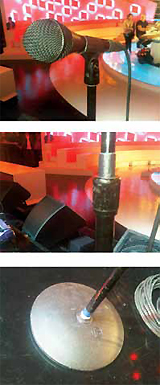The attention to detail that takes place in preparing a rock show can be mind boggling. For example, I listed out the factors we account for in setting up the lead vocal mic for the Red Hot Chili Peppers.
|
http://a3.twimg.com/profile_images/313810739/psw_twitter_reasonably_small.jpg Article is providedby ProSoundWeb |
Check it out:
1) The mic. Anthony has been using Audix OM7 dynamic mics for over 20 years now. The OM7 exhibits high feedback stability and picks up very little room sound compared to other mics. This allows me to capture an “up close and personal” vocal sound, and if I need more air or space, it’s easy to add with a vocal reverb. Also, these mics are very durable, and the spring steel grills don’t dent when dropped.
Conversely, the OM7 pick-up pattern falls off in volume very quickly if you’re not lips to grill on the mic. Also, it tends to be more susceptible to moisture than other microphones. Since Anthony sings close to the mic and we switch to a fresh mic at mid-show and again before encore, those drawbacks are not an issue in this application.

2) The mic stand is integral to the performance so it must be exact. We use the Atlas MS12 – a straight stand, no boom. The “12” stands for 12 pounds, and that is the weight he’s used to swinging around. These stands have a slightly larger diameter tube than the Euro manufactured metric stands and are less likely to bend. The metal clutch is more durable than the plastic clutches, and the larger diameter cast metal base makes it less likely to tip over as well.
3) The cable must be extremely durable. We use Belden 8412 or equivalent with real rubber jacketing (not plastic), braid shield, multiple fiber wraps and preferably a twine filler. It must have minimal stretch, withstand abuse and be resistant to tangling.
4) The clip. We use a Shure SM58 clip because the Audix clip is too rubbery. It’s the older version clip that is not flared up top. It requires the mic to be slid – not popped – into place, and the mic won’t jump out when the stand is swung or bounced. Also, we heat up new clips with a lighter and bend them open so they get the proper grip on the mic – not too tight or loose.
 5) Taping the cable. The mic cable is taped to the mic to prevent it from being accidentally unplugged. This is done with a single non-overlapping layer of black gaff tape. It’s critical that the mic (and tape) slide out of the clip not too easily but also not jamming either.
5) Taping the cable. The mic cable is taped to the mic to prevent it from being accidentally unplugged. This is done with a single non-overlapping layer of black gaff tape. It’s critical that the mic (and tape) slide out of the clip not too easily but also not jamming either.
6) Taping the stand. A ring of gaff tape is wrapped around the inner pole to prevent the stand from getting shorter should he bang it on the ground in a downward direction. Each stand is measured to be exactly 55.75 inches in height, base to thread ring. There are always at least two spare built-and-measured stands as backups. We go through dozens over the course of a tour.
7) Boring out the clip. The stock old-school Shure clip has a sharp-ish edge that prevents the taped mic from sliding out smoothly. To solve this, the rear sharp of each mic clip is beveled and rounded out with a Leatherman tool or any sharp knife and checked for “slide.”
8) Clip rotation tension. The clip needs to hold the mic firmly at an angle and not loosen easily. Cheaper imitation clips do not have the tension washer stacks inside and will come loose when repeatedly rotated.
9) Cable length. The mic cable is 50 feet long and plugged into a stagebox located center stage.
10) Spare mic. An identical spare taped vocal mic is coiled at center stage. The main mic, spare, and a wireless mic all are plugged into a three-way SoundTools switcher located at the monitor position. This allows Anthony to grab any of the three mics and have it instantly switched in line to both monitors and house.
There you have it – now you know how we prep snake channel 24!
For more news and information for the audio professional visit ProSoundWeb.
